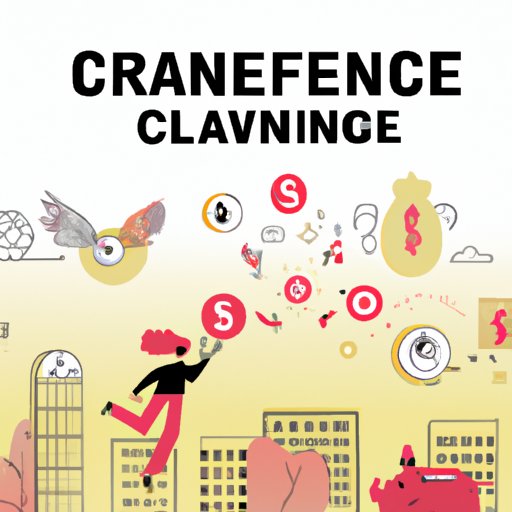Introduction
Businesses often need access to capital in order to expand, invest in new projects, or just to keep operating. Traditional bank loans are one option, but they can be difficult to obtain and come with strict requirements. That’s where creative financing comes in. Creative financing is a way for businesses to access capital without relying on traditional sources like banks.
Definition of Creative Financing
At its core, creative financing is simply a way for businesses to access capital without relying solely on traditional methods like bank loans or lines of credit. It involves leveraging alternative funding sources such as venture capital, crowdfunding, asset-based financing, private equity, factoring, angel investors, and government programs. These options provide businesses with access to capital that they may not have been able to obtain through traditional means.
Exploring the Different Types of Creative Financing Solutions
There are many different types of creative financing solutions available, each with its own set of benefits and drawbacks. Here’s an overview of some of the most popular options:
Traditional Bank Loans
Traditional bank loans are still a viable option for businesses looking for capital. Banks typically require collateral and a good credit rating in order to qualify for a loan. The approval process can also be lengthy and complex, making it difficult for some businesses to get the funding they need.
Venture Capital
Venture capital is a type of financing provided by investors who are willing to take risks in exchange for potential profits. This type of financing is often used by startups or other high-growth companies. Investors provide capital for a percentage of ownership in the company, and the funds can be used to launch new products or services.
Crowdfunding
Crowdfunding is a type of financing where individuals or groups donate money to a cause or project. Businesses can use crowdfunding platforms to raise money for new products or services. The money raised is usually given in exchange for rewards or incentives.
Asset-based Financing
Asset-based financing is a type of loan that uses the value of a business’s assets as collateral. This type of financing is typically used by businesses that have difficulty obtaining traditional bank loans due to bad credit or lack of collateral. The loan amount is determined by the value of the assets being used as collateral.
Private Equity
Private equity is a type of financing provided by investors who purchase a stake in a company. Private equity investors provide capital in exchange for a percentage of ownership in the company. This type of financing is often used by companies that are looking to grow or expand their operations.
Factoring
Factoring is a type of financing where a company sells its accounts receivable at a discount in order to access immediate cash. This type of financing is often used by businesses that need quick access to cash but don’t want to take on additional debt.
Angel Investors
Angel investors are individuals who provide capital to startups or early-stage companies in exchange for a percentage of ownership. Angel investors typically look for companies that have high growth potential and are willing to take risks in order to make a return on their investment.
Government Programs
The government provides a variety of programs to help businesses access capital. These programs include grants, tax incentives, and loan guarantees. Government programs are typically aimed at helping small businesses or those in certain industries access capital.
How Can Creative Financing Help Your Business Grow?
Creative financing can offer many benefits to businesses that are looking to grow and expand. Here are some of the key benefits:
Access to Capital
One of the biggest benefits of creative financing is access to capital. Alternative financing options can provide businesses with the funds they need to invest in new projects, hire new employees, or launch new products and services.
Increased Potential for Growth
Creative financing can help businesses expand and scale up their operations. With access to capital, businesses can invest in new projects and hire new employees, which can lead to increased revenue and profits.
Improved Credit Ratings
By using creative financing options, businesses can improve their credit ratings. This can make it easier to obtain traditional financing in the future.
Reduced Debt Burden
Creative financing can help businesses reduce their debt burden. By leveraging alternative financing sources, businesses can avoid taking on additional debt, which can help them remain financially stable.

Analyzing the Benefits and Risks of Creative Financing
Creative financing offers many benefits, but it also comes with some risks. Here’s a look at the benefits and risks of creative financing:
Benefits
The main benefit of creative financing is access to capital. This can help businesses invest in new projects, hire new employees, and launch new products and services. Additionally, creative financing can help businesses improve their credit ratings and reduce their debt burden.
Risks
The main risk of creative financing is that businesses can lose control of their company if they take on too much debt or give away too much equity. Additionally, businesses should be aware that some creative financing solutions come with higher interest rates and fees than traditional bank loans.

Strategies for Finding and Utilizing Creative Financing Options
Finding the right creative financing option can be challenging, but there are some strategies that businesses can use to make the process easier. Here are some tips for finding and utilizing creative financing solutions:
Research Different Financing Options
Before deciding on a financing solution, it’s important to research different options. This will help businesses understand the different types of financing available and determine which option best meets their needs.
Evaluate Your Business Needs
Once businesses have identified potential financing options, they should evaluate their business needs to determine which option is best suited for their specific situation. This will ensure that businesses choose the most suitable option for their needs.
Identify Potential Sources of Capital
Businesses should identify potential sources of capital that could be used to finance their projects. This includes traditional sources like banks as well as alternative sources such as venture capital and crowdfunding.
Create a Financial Model
Creating a financial model can help businesses analyze the potential returns of different financing options. This will help them determine which option is likely to provide the best returns.
Negotiate Terms
Once businesses have identified their preferred financing option, they should negotiate terms that are favorable to both parties. This will help ensure that businesses get the best deal possible.

A Guide to Applying for Creative Financing Solutions
Once businesses have identified the right creative financing solution for their needs, they should begin the application process. Here’s a guide to applying for creative financing solutions:
Understand the Requirements of the Financing Source
Before applying for financing, businesses should make sure they understand the requirements of the financing source. This will help them ensure that they meet all the necessary criteria and have the documents needed to submit a successful application.
Prepare a Comprehensive Business Plan
Businesses should prepare a comprehensive business plan that outlines their goals, objectives, and strategies. This will help demonstrate to the financing source that the business is serious about achieving its goals.
Gather Necessary Documentation
Businesses should gather all the necessary documentation required by the financing source. This includes financial statements, tax returns, and other documents that demonstrate the business’s financial health.
Submit an Application
Once businesses have gathered the necessary documents, they should submit an application for the financing source. This should include a detailed description of the business’s goals and objectives and how the financing will be used.
Negotiate Terms
Businesses should negotiate the terms of the financing with the financing source. This will help ensure that the terms are favorable to both parties.
Obtain Approval
Once the terms have been negotiated, businesses should obtain approval from the financing source. This will allow them to access the funds they need to grow and expand their business.
Conclusion
Creative financing is a great way for businesses to access capital and grow. There are many different types of creative financing solutions available, each with its own set of benefits and risks. Businesses should research different financing options, evaluate their business needs, identify potential sources of capital, create a financial model, and negotiate terms before applying for creative financing solutions. By understanding the different types of creative financing solutions and following these steps, businesses can find the right option for their needs and access the capital they need to grow and succeed.
(Note: Is this article not meeting your expectations? Do you have knowledge or insights to share? Unlock new opportunities and expand your reach by joining our authors team. Click Registration to join us and share your expertise with our readers.)
